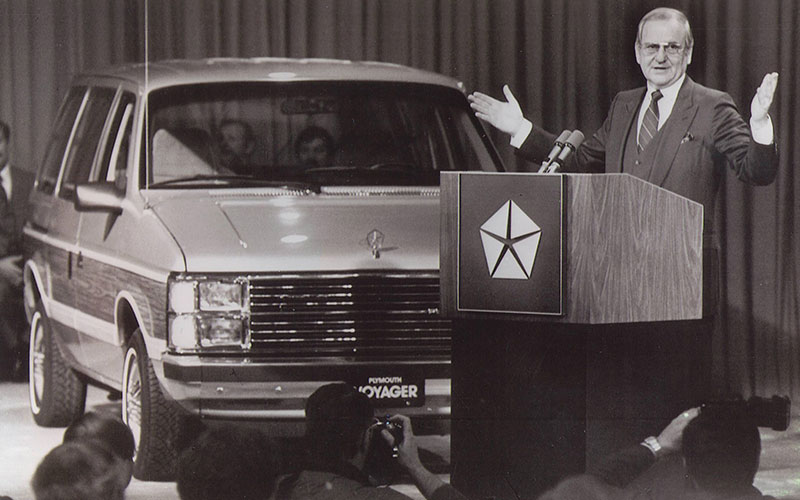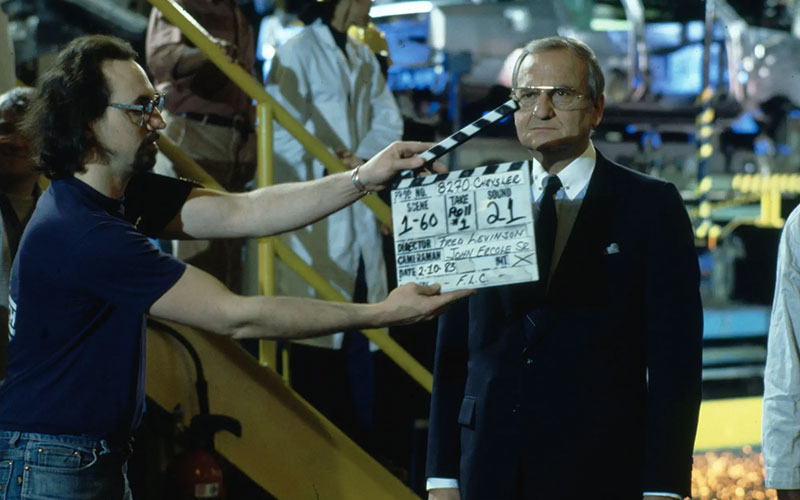Who Was Lee Iacocca?
An irrepressible salesman and continual innovator, few automotive figures proved more pivotal in the latter half of the 20th century than Lee Iacocca.
Boardroom Titan

Born in Allentown, PA in 1924 to Italian immigrant parents, Lido “Lee” Iacocca would go on to head two major American automakers, become the country’s most recognizable pitchman, and leave a legacy that reverberates today, thirty years after his retirement.
Iacocca’s list of notable credits is long, but he is best remembered for his meteoric rise at Ford Motor Company, one that included his bringing the youth-oriented Mustang to a baby boomer generation hungry for freedom and adventure, and for shepherding Chrysler back from the brink of collapse in the early 1980s. Along the way, Iacocca, an engineer by training, built a reputation as a straight-shooting executive and charismatic salesman. In the latter half of the 20th century, no other American auto executive was more impactful or more transformative than Lee Iacocca.
Early Years

Lee Iacocca graduated Allentown High School in 1942. Even as a young man, Iacocca set his sights high. His dream job? To head Ford Motor Company. In pursuance of these lofty aspirations, he attended Lehigh University, receiving a degree in industrial engineering. From there he was accepted to Princeton University where he completed a master’s degree in mechanical engineering. He landed a job at Ford Motor Company in 1946.
56 for 56

Iacocca may have started out in the engineering department, but he knew his true calling lie elsewhere. In short order, he transferred to sales and marketing. As an assistant sales manager in Philadelphia, Iacocca came up with a new campaign he dubbed “56 for 56.” Customers could buy a new 1956 Ford for 20 percent down and $56 dollars a month for three years. The campaign was so successful that Ford incorporated it into its national marketing. Iacocca quickly found himself promoted to D.C. district sales manager.
From there, Iacocca’s rise at Ford was close to meteoric. In 1960, he was promoted to V.P. and general manager of the Ford Division. It was during this time Iacocca was instrumental in the launch of the Ford Mustang, a car aimed at the growing baby boomer youth market. Iacocca rightly identified the generational desire for freedom and a break with convention. The Mustang was perfect to capitalize on this market and became a massive sales hit for Ford.

In 1965, Iacocca was made V.P. of cars and trucks. By ’67, Iacocca had made executive vice-president. And in 1970 Lee Iacocca attained his long-sought dream of becoming the President of Ford Motor Company. Aside from steering one of the country’s largest corporations, one of Iacocca’s biggest challenges was keeping Henry Ford II, grandson to Henry Ford and Ford CEO, happy. Henry Ford II was notoriously difficult to work for, often given to paranoia and unreceptive to counsel.
Despite successes like the Mustang, the resurgence of the Mercury brand, and many others, Iacocca’s eight years at the top of Ford came to an end in 1978 when Hank the Deuce fired him. When asked why he fired Iacocca, when that very year Ford had posted a $2 billion dollar profit, Ford answered, “Sometimes you just don’t like someone.” Iacocca wouldn’t be hunting for a job for long. He quickly found himself scooped up by Chrysler. A company in dire need of fresh ideas and new leadership.
The K-Car (Or How Iacocca Saved Chrysler)

Even more than his successes at Ford, Lee Iacocca is best remembered for his stint as President of Chrysler. In the late 1970s, Chrysler was struggling. Their failure to pivot to smaller economy cars, recalls, and general mismanagement had put the company on the brink of bankruptcy. Iacocca’s task was simple enough, save one of the country’s largest employers from folding.
In 1979, Iacocca went before the US Congress to ask for a government bailout, in the form of a loan of $1.5 billion dollars. Always the persuasive salesman, Iacocca was able to convince Congress that allowing Chrysler to fold would be too costly for the national economy. As Iacocca pointed out, with over 600,000 employees nationwide, the impacts of a Chrysler failure would be felt right down to Congresspeople’s individual districts, with all but two House districts having a Chrysler dealership.
Iacocca secured the government loan for Chrysler. His three-year plan for turning the company around (a requirement for the loan) would prove successful beyond all expectations. Central to this plan was the development of a new platform for economy cars.

The K-car platform was developed off the L-platform that had been used for the Dodge Omni and Plymouth Horizon. The new K-cars would be small front-wheel drive cars running either a 2.2L or 2.6L four-cylinder engine. Build quality, long a weak point for Chrysler was a high priority. The new modus operandi for Chrysler which Iacocca promoted with the K-cars was “modern engineering made simple.” Given the oil shocks of the 1970s, fuel efficiency was also a priority. The new Dodge Aries and Plymouth Reliant were able to achieve up to 26 city and 41 highway MPG (good numbers even today).
Soon the Dodge 400 and Chrysler LeBaron would follow on the K-platform. Iacocca took the rather unusual step of becoming Chrysler’s main pitchman, appearing on television commercials and famously advising viewers, “If you can find a better car, buy it.” Americans did, buying K-cars by the hundreds of thousands a year and allowing Chrysler to pay back their ten-year government loan seven years early in 1983, and with the stock warrants included in the deal, the US government actually made a hefty $350 million dollar profit.
Jeeps, Minivans, and Bowing Out

Also in 1983, Iacocca realized one of his longstanding ideas, one Ford had passed on, that of a minivan. The Dodge Caravan and Chrysler Voyager would be the beginning of a major automotive phenomenon. But Iacocca still wasn’t done reshaping the automotive business. In 1987, he facilitated Chrysler’s acquisition of AMC. The most important aspect of which was the valuable Jeep brand and their newest vehicle, then in development, the Jeep Grand Cherokee.
The late 1990s saw an exodus of top talent from Chrysler boardrooms. As Iacocca was preparing to retire, this left him with a few choices for a successor to run Chrysler. Iacocca’s first choice would have been Bob Lutz, Chrysler’s Head of Global Product Development (you may remember Bob from his role in the creation of the Dodge Viper). But at the time, Lutz and Iacocca weren’t on the best terms and Lee opted for Bob Eaton, head of GM’s European Division instead. It was Eaton who would later foster the Daimler/Chrysler merger, a move which nearly killed the company all over again. Iacocca said the decision to go with Eaton over Lutz was his biggest professional regret. (And that’s saying something considering Iacocca was also responsible for the Ford Pinto.)

Lee Iacocca retired as President and CEO of Chrysler in 1992. He made the most of his golden years, passing in 2019 at the age of 94. It’s hard to imagine what the American automotive industry would have looked like without Iacocca’s singular contributions.









